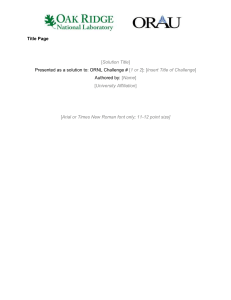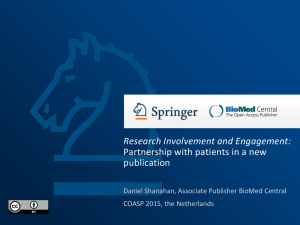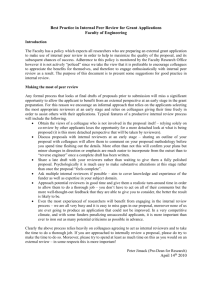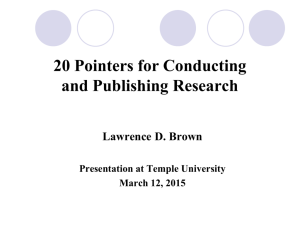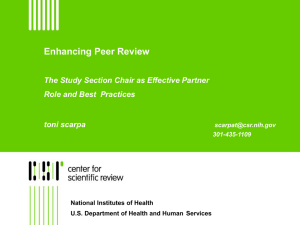The Grants Pathway at NIH - University of Texas Health Science
advertisement
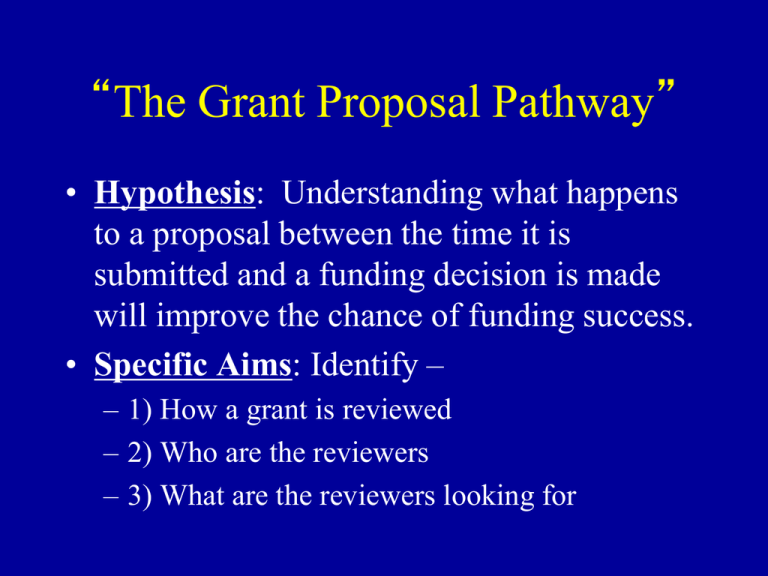
“The Grant Proposal Pathway” • Hypothesis: Understanding what happens to a proposal between the time it is submitted and a funding decision is made will improve the chance of funding success. • Specific Aims: Identify – – 1) How a grant is reviewed – 2) Who are the reviewers – 3) What are the reviewers looking for Your Grant NIH or Other Funding Agency ? months later.. “Pink Sheet” Critique and Funding Decision Your Grant NIH or Other Funding Agency ? months later.. Let’s look inside the Black Box! “Pink Sheet” Critique and Funding Decision How is NIH Organized? • Director’s Office – sets policies, represents NIH to Congress, public, has modest discretionary $, etc. • Institutes and Centers (I/C’s) – (Congress puts $$$ Here) – Each has focus, e.g., NCI, NIGMS, NEI, NHBLI, etc. – Develop Specific Programs and Priorities – Provide Money to Make Grant Awards • Center for Scientific Review (CSR) – special function to review grants via study sections (sometimes call Scientific Review Groups or SRG’s) directed by Scientific Review Officers (SRO’s). No grant $$ to distribute National Institutes of Health Office of the Director National Institute on Aging National Institute on Alcohol Abuse and Alcoholism National Institute of Allergy and Infectious Diseases National Institute of Arthritis and Musculoskeletal and Skin Diseases National Cancer Institute National Institute of Child Health and Human Development National Institute on Deafness and Other Communication Disorders National Institute of Dental and Craniofacial Research National Institute of Diabetes and Digestive and Kidney Diseases National Institute on Drug Abuse National Institute of Environmental Health Sciences National Eye Institute National Institute of General Medical Sciences National Heart, Lung, and Blood Institute National Human Genome Research Institute National Institute of Mental Health National Institute of Neurological Disorders and Stroke National Institute of Nursing Research National Institute of Biomedical Imaging and Bioengineering National Center for Complementary and Alternative Medicine Fogarty International Center National Center for Research Resources National Library of Medicine National Center on Minority Health and Health Disparities Clinical Center Center for Information Technology Center for Scientific Review Study Sections CSR has Many Study Sections, e.g. • • • • • • Arthritis, Connective Tissue, and Skin Auditory System Membrane Biochem. & Biophysics Biomaterials Cancer Genetics Cellular Signaling & Regulatory Systems The Grant Pathway NIH = National Institutes of Health Your Grant 1 CSR - Study Section that oversees scientific review and Assignment of Priority Score Two Assignments Made Institute ($$) that makes Final Funding Decision 2 3 Scientific Review & Priority Score 4 $$$ to Texas! Relationship of Study Sections (Scientific Review) to Institutes ($$) ~200 Study Sections -- CSR ~ 20 Institutes Biochemistry NCI Clinical Oncology NEI Genetics NIDDK Epidemiology of Cancer NIGMS Lung Injury, Repair NHBL Microbial Physiology Etc. Oncological Sciences Etc. 1) Scientific Review is Done by Study Sections 2) Funding Decisions made by Institutes How does the Study Section Operate? • SS has 15-25 members (regular & ad hoc) selected for their expertise in the area of the applications the study section reviews and is overseen by a Scientific Review Officer • Scientific Review Officers (SRO) oversee individual SS’s; receive applications from CSR main office and assign each application to primary & secondary reviewers before the review meeting • Primary & Secondary Reviewers prepare written reviews and post in advance on NIH website • All SS members meet to review all grants – Chair runs meeting (not NIH employee) – SRO serves as a ‘resource’ about policy & protocol • Study Sections are far more diverse than one might anticipate Cellular Signaling and Regulatory Systems Study Section •The Cellular Signaling and Regulatory Systems (CSRS) study section reviews applications that focus on the initiation and execution of programs that control cellular homeostasis and physiology. A distinguishing characteristic of these applications is an emphasis on signaling networks and the coordination of processes related to cell proliferation, survival, and growth. •Cell cycle regulation, mitosis, meiosis, checkpoint controls, regulation by ubiquitination •Proteolytic mechanisms associated with cell cycle, senescence and death •Programmed cell death and apoptosis, particularly their regulation in the context of stress, growth, and transformation. •Proliferation & growth control by the nucleus; pathways regulating transcription •Integrative cell physiology, e.g., stress, clocks, cellular modeling; cell differentiation and transformation •Basic studies of cytokine signaling •Application of state-of-the-art technologies such as imaging and computational modeling of cellular signaling networks Study Section The primary and secondary reviewers will: 1) read your proposal thoroughly (you hope!) and understand it (you really hope!!) 2) evaluate it (priority score), 3) explain it AND justify their evaluation to the study section, 4) prepare a written summary and evaluation. They present to the full study section (~15-20 people) most of whom will not have read the complete grant. After discussion, every member gets an equal vote. 50-100 grants in 2 days – You must be clear and to the point!! (1) Get peer review from critical colleagues: EARLY and OFTEN!! (2) Write different sections of the grant for ‘different’ reviewers (3) Grant must be crystal clear and explicit! Page limits make this critically important. (How long should one plan to write?) Peer Review Feasibility is Is Critical!! Critical!! Study Section Scores assigned Guidance on weighing strengths and weaknesses Overall Impact Score • 1 Exceptional Strengths High Impact Moderate Impact Low Impact 2 Outstanding 3 Excellent 4 Very Good 5 Good 6 Satisfactory 7 Fair 8 Marginal 9 Poor Weaknesses Non-numeric score options: NR = Not Recommended for Further Consideration, DF = Deferred, AB = Abstention, CF = Conflict, NP = Not Present. Priority Scores and Percentile Rank • Priority Scores assigned by Study Sections based on average of all reviewers scores • Percentile Rank assigned afterwards to normalize scoring across study sections and over time • Funding determined by percentile rank 1) Study Section Review 2) Institute Funding Decision Approved Applications Receive Percentile Scores 1st John Doe (Biochem. SS) 2nd Your Grant (Oncology SS) 13th Stancel (Genetics SS) 27th Jane Doe (Micro. SS) National Cancer Institute (Budget from Congress) Etc. Etc. Payline “Streamlined” Not Recommended for Further Consideration 1) Your Grant 2) John Doe 3) Stancel 4) Jane Doe Etc. Etc. Etc. $ $ $ - The Institute’s Council may make some changes in the rankings based upon their particular goals and needs. It’s Great Science, BUT will it really help us find a cure for the plague? Grant Contacts, Interactions, and Information in Various Phases • Pre Submission: Institute Program Officials – Assess Institute’s Interest in Your Proposal – Provide Advice & Potential SS Assignment • Submission – Review : CSR’s Scientific Review Officers (SRO’s) who oversee study sections – Questions about application – Submitting additional information • Post Award : Assigned Program Officer at Funding Institute • NEVER CONTACT A STUDY SECTION MEMBER ABOUT YOUR GRANT!!! Help your proposal be assigned appropriately – You can Recommend Assignments -Call Institute staff (be respectful) – they want to help -Study section rosters are public information (‘regular’ members) Remember – The agency does not care about supporting you as an individual. They only want to fund you if the research you propose helps them achieve one of their objectives. Important Sources of Information • NIH Website – – general information about types of Grants – ‘standard’ information, e.g., general instructions, receipt dates, etc. • NIH Guide – weekly information about program changes, Request for Applications (RFA’s) • Institute Home Pages – Information about areas of interest – Names and Contact information for Program Officers • Center for Scientific Review Website – Detailed information about preparing applications – Names and Contact information for Scientific Review Officers – Study Section Descriptions and Rosters – Instructions for Reviewers!!! Your Job as Principal Investigator (PI) 1) Help your proposal be assigned to a) The appropriate study section b) The appropriate institute 2) Make the primary & secondary reviewers’ jobs easy – they’ll appreciate it and become your advocates. a) Give the proposal a focus that helps them understand it b) Make it easy for them to read c) Make it easy for them to explain it to the study section d) Make it easy for them to justify a good evaluation 3) Help the other members of the study section who do not read the entire grant. NEVER OVERESTIMATE THE REVIEWERS!!! USE THE FOLLOWING TOOLS – IN ORDER – TO PREPARE YOUR GRANT 1) The Internet to identify a) Study section rosters b) Institute contact personnel c) The Institute’s goals and interests 2) The telephone to a) Assess interest in your project b) Consider study section/institute assignments 3) The word processor to -Actually write the grant! HELP THE REVIEWERS – When you Write the Grant! 1) Read and follow your instructions and know the reviewers’ 2) Give the proposal a focus, and have colleagues help you evaluate it (write a novel, not a collection of short stories) 3) Build the application around your focus (the hypothesis or scientific question being addressed) 4) Help the reviewer prepare his/her critique and presentation to the study section (know what he/she is looking for and write it for them - CLEARLY!) 5) Get rigorous, critical review (before you send the grant!) a) from “experts” b) from well rounded “generalists” What will reviewers look for in your grant? Core Review Criteria (in instructions to reviewers on NIH website) Significance Investigators Innovation Approach Environment Innovation • Innovation. Does the application challenge and seek to shift current research or clinical practice paradigms by utilizing novel theoretical concepts, approaches or methodologies, instrumentation, or interventions? Are the concepts, approaches or methodologies, instrumentation, or interventions novel to one field of research or novel in a broad sense? Is a refinement, improvement, or new application of theoretical concepts, approaches or methodologies, instrumentation, or interventions proposed? REMEMBER - Reviewers are just like anyone else, EXCEPT, they have to review your grant in Addition to all their normal work! Don’t overestimate them, and be certain to help them out! Don’t Forget….. • You must be registered in eRA Commons to submit applications electronically • Individuals do NOT submit or receive grants – institutions do – Consult the Office of Sponsored Projects well in advance of agency submission dates – Remember you will need information and approvals (e.g., animal welfare, human subjects, conflict of interest, biohazards, chemical safety, etc.) And Don’t Ever Forget….. Talk to People at the Funding Agency Get peer review from critical colleagues: Do It EARLY and OFTEN!! Never Overestimate the Reviewers GOOD LUCK! And Remember that you can get help from OSP, ARA, NIDP, and your colleagues – so don’t hesitate to ask!
